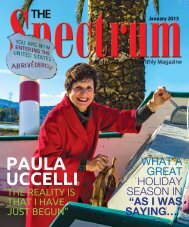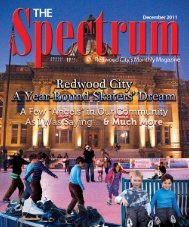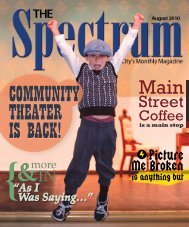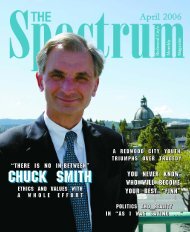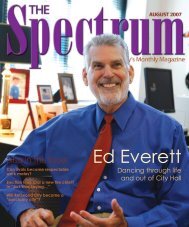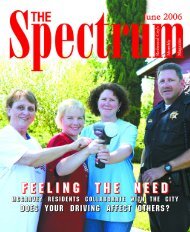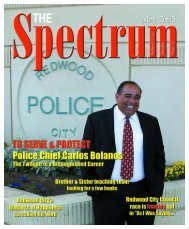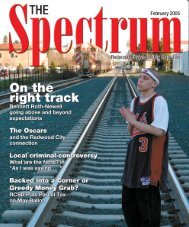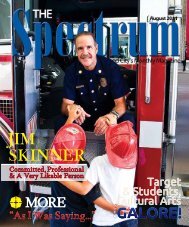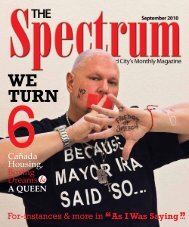Spectrum June 2013 Issue - The Spectrum Magazine - Redwood ...
Spectrum June 2013 Issue - The Spectrum Magazine - Redwood ...
Spectrum June 2013 Issue - The Spectrum Magazine - Redwood ...
Create successful ePaper yourself
Turn your PDF publications into a flip-book with our unique Google optimized e-Paper software.
As I Was<br />
Saying… Publisher<br />
| Steve Penna<br />
I, like many residents of San Mateo County, was<br />
not in favor of changing the election process for<br />
the county supervisor seats from “at large” to<br />
districts. Voters approved that change last year<br />
and, since then, sitting supervisors have been<br />
concentrating more on the cities and areas within<br />
their boundaries.<br />
<strong>The</strong> main argument to wanting “at large” seats<br />
was that supervisors voting on issues outside of<br />
their represented area should be held accountable<br />
by voters if they are making decisions for all<br />
districts. <strong>The</strong>y still vote that way today although<br />
elected now by individual districts. I hope that is<br />
not too confusing.<br />
Anyway, for those of us who are passionate<br />
about and have been waiting for a county<br />
supervisor to pay some much-needed attention<br />
to the North Fair Oaks (NFO) unincorporated<br />
area of <strong>Redwood</strong> City, this change has now been<br />
welcomed as Supervisor Warren Slocum is<br />
making an attempt to focus on the neighborhood I<br />
was born and raised in.<br />
Now, I am not saying that Slocum holding<br />
regular community meetings, cleanup days or<br />
glorified festivals is a large step forward, but it<br />
is a step nonetheless and it should be noticed and<br />
acknowledged. But let’s take it a step further and<br />
not just concentrate on all the touchy-feely good<br />
stuff that gets those doing it mentioned in media<br />
outlets. Let’s get to work!<br />
I always get a real laugh from all the elected<br />
officials and wannabes who attend the NFO<br />
Community Festival in the summer, where they<br />
try to act like they are supportive and a part of<br />
the neighborhood when you know that is the only<br />
time you will see them in that neighborhood. It<br />
is absolutely embarrassing for me to watch them<br />
pretend that they care when, in reality, they attend<br />
that event to create the illusion that they do. It is<br />
actually pathetic and is one of the reasons that the<br />
neighborhood continues to cope with the existing<br />
problems they have. <strong>The</strong> ones who can really help<br />
don’t spend any time there.<br />
<strong>The</strong>re are some unique issues facing that<br />
neighborhood, and we should all be concerned<br />
and get involved with them because we interact<br />
with each other on a daily basis. I would bet<br />
most of you probably don’t even realize that our<br />
community is split and represented by different<br />
governmental agencies. Let me try to break it<br />
down in simple terms.<br />
Incorporated areas of <strong>Redwood</strong> City are<br />
represented by our City Council and served by<br />
the <strong>Redwood</strong> City Police and Fire departments,<br />
water districts, Parks and Recreation Department<br />
and so on. Unincorporated areas are represented<br />
by county supervisors, the county Sheriff’s<br />
Office, county fire services and so on. <strong>The</strong> areas<br />
www.<strong>Spectrum</strong><strong>Magazine</strong>.net<br />
of <strong>Redwood</strong> City that are unincorporated are the<br />
NFO and Emerald Hills neighborhoods. Got it?<br />
So if you live in the incorporated area and your<br />
local tax dollars stay there and vice versa, why<br />
should we care about “them”? Well, let me give<br />
you a few reasons. In many areas of our city, one<br />
side of the street is incorporated and the other<br />
is not. That alone should be enough. But if that<br />
is not, here are a few others. 1) Students in both<br />
areas go to some of the same schools. 2) Crime<br />
control information is shared and the involved<br />
agencies work together to reduce and control it. 3) We<br />
share garbage and recycling services and therefore<br />
the same concerns and pricing. I could give a few<br />
more examples, but I think you get the idea that<br />
we are neighbors regardless of boundaries. We<br />
need to communicate and need to interact.<br />
<strong>The</strong> NFO Community Center location<br />
on Middlefield is a prime example. Part of<br />
the property is unincorporated and part is<br />
incorporated. But they work together to provide<br />
services like the senior center and the library.<br />
So what do we need to concentrate on or give<br />
some attention to? Well, I am no expert, but I do<br />
keep track of activity in my old neighborhood by<br />
shopping there, volunteering there and visiting<br />
friends and associates who live there. <strong>The</strong> issues<br />
in that neighborhood are more societal than<br />
anything else, and those types of issues are hard<br />
to work on. I mean, the federal government<br />
cannot even do that. But we must try.<br />
I was impressed to read a statement from<br />
Slocum that captured the neighborhood: “I have<br />
come to learn, however, that in many ways there<br />
are two San Mateo Counties. One is punctuated<br />
by wealth, software and biotechnology. <strong>The</strong> other<br />
is a place where 40 percent of third-graders don’t<br />
read at grade level, 67,000 adults don’t have health<br />
insurance, 180,000 are without dental insurance<br />
and more than 50,000 cannot afford necessary<br />
medications. <strong>The</strong> percent of families living in<br />
poverty has increased significantly countywide,<br />
and there is an area between Atherton and central<br />
<strong>Redwood</strong> City where more than 20 percent of the<br />
people live in poverty. Government policies that<br />
shape our work, families and lives could be better,<br />
and we all know it. We also know that government<br />
can be more efficient, more responsive and cost<br />
less, and I made it my personal responsibility to<br />
do just that during my time in office. I like nothing<br />
better than rolling up my sleeves, tackling problems<br />
one by one and making things work better,”<br />
Slocum stated.<br />
Low-income families are among the biggest<br />
issues facing that area, and those are the issues<br />
that need attention. I sometimes wonder who is<br />
actually supposed to feel good after the cleanup<br />
days, outside office hours and coffee-with-cops<br />
type outreach? But gathering information is a<br />
vital first step and what those types of activities<br />
are supposed to foster.<br />
Someone once told me that “most of us are<br />
just a paycheck or two away from poverty.” That<br />
has always stuck in my mind and is probably the<br />
reason I buy the special things I like in bulk. That<br />
way, if I can’t afford it next month, I have it.<br />
So how do Slocum and others like him address<br />
those issues? It sounds clichéd, but it is most<br />
definitely “thinking outside the box.” Knowing<br />
your community and the existing problems and<br />
developing new ways of addressing them is key.<br />
All you need to do is look at the violence in East<br />
Palo Alto and realize that they need someone to<br />
“think outside the box” and try something different.<br />
In fact, the Sheriff’s Office or some other law<br />
enforcement agency needs to intervene there<br />
to assist as they had to do a decade or so ago to<br />
reduce the crime and killings that have exploded<br />
again recently. How many lives have been lost<br />
because of the lack of leadership in finding<br />
solutions? That is something a county supervisor<br />
might want to take on. In fact, one of the current<br />
supervisors, Don Horsley, was county sheriff<br />
when they had to assist back then and might be<br />
the one to lead the effort now.<br />
As you may remember, cursed by a flourishing<br />
drug trade and violent gang wars, East Palo Alto<br />
recorded the highest murder rate in the nation<br />
during 1992. A partnership of sorts with the Sheriff’s<br />
Office quickly reduced crime and the murder rate.<br />
At that time, that was “thinking outside the box.”<br />
Slocum’s approach in part seems to be gathering<br />
information, and he is doing quite well at that.<br />
Every Wednesday, he holds weekly evening office<br />
hours in NFO. Residents are encouraged to drop<br />
in and share their concerns. <strong>The</strong> hours are from 5<br />
p.m. to 8 p.m. at the Fair Oaks Community Center<br />
at 2600 Middlefield Road in <strong>Redwood</strong> City. In<br />
response, he is getting interest.<br />
He also has a great communicator of information<br />
in his own home. His wife, Maria Diaz-Slocum,<br />
attended Hoover School in the NFO area and<br />
graduated from Sequoia High School. She currently<br />
works at the NFO library and serves on the board<br />
of trustees for the <strong>Redwood</strong> City School District.<br />
She has years of knowledge to share.<br />
Recently the “Be Seen Keepin’ It Clean” cleanup event<br />
in NFO attracted over 225 residents volunteering<br />
to help in the effort. <strong>The</strong> neighborhood is better off<br />
because of this collaborative effort with the North<br />
Fair Oaks council.<br />
<strong>The</strong> CityTrees organization is currently working<br />
with Slocum to try to get a tree pruning and<br />
(continues on page 24)



